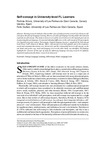Identificador persistente para citar o vincular este elemento:
https://accedacris.ulpgc.es/jspui/handle/10553/43213
| Campo DC | Valor | idioma |
|---|---|---|
| dc.contributor.author | Arnáiz Castro, Patricia | en_US |
| dc.contributor.author | Guillén García, Félix | en_US |
| dc.date.accessioned | 2018-11-21T13:27:30Z | - |
| dc.date.available | 2018-11-21T13:27:30Z | - |
| dc.date.issued | 2012 | en_US |
| dc.identifier.issn | 1447-9508 | en_US |
| dc.identifier.uri | https://accedacris.ulpgc.es/handle/10553/43213 | - |
| dc.description.abstract | Existing research indicates that no other area of study presents as much of a threat to selfconcept as doesforeign language learning. However, few foreign language learning studies have focused explicitly on self-concept. This study is timely in view of the current interest by the Spanish government in promoting foreign languages. It examined individual differencesin the self-concept of 216 participants in a Spanish university context. Participants, English language learners, completed the Self-concept Scale Form 5-AF5 (García & Musitu, 2001). Self-concept levels both globally and in the academic, social and emotional dimensions were determined, and the relationship between self-concept, on the one hand, and gender, age, mark and language level on the other hand, was identified. The findings highlight the relevance of this type of study for informing language learning research. In addition, important implications for future research are discussed. | en_US |
| dc.language | eng | en_US |
| dc.publisher | 1447-9508 | - |
| dc.relation.ispartof | International Journal of the Humanities | en_US |
| dc.source | International Journal of the Humanities [ISSN 1447-9508],v. 9, n. 4, p. 81-92 | en_US |
| dc.subject | 58 Pedagogía | en_US |
| dc.subject | 57 Lingüística | en_US |
| dc.subject | 61 Psicología | en_US |
| dc.subject.other | Foreign Language Learning (FLL) | en_US |
| dc.subject.other | Self-concept | en_US |
| dc.subject.other | Mark | en_US |
| dc.subject.other | Language Level | en_US |
| dc.title | Self-concept in university-level FL learners | en_US |
| dc.type | info:eu-repo/semantics/Article | es |
| dc.type | Article | es |
| dc.identifier.doi | 10.18848/1447-9508/CGP/v09i04/43205 | en_US |
| dc.identifier.scopus | 84856151360 | - |
| dc.contributor.authorscopusid | 54921188600 | - |
| dc.contributor.authorscopusid | 16636403500 | - |
| dc.description.lastpage | 92 | - |
| dc.description.firstpage | 81 | - |
| dc.relation.volume | 9 | - |
| dc.investigacion | Ciencias Sociales y Jurídicas | en_US |
| dc.type2 | Artículo | en_US |
| dc.date.coverdate | Diciembre 2011 | |
| dc.identifier.ulpgc | Sí | es |
| dc.description.sjr | 0,1 | |
| dc.description.sjrq | Q4 | |
| item.fulltext | Con texto completo | - |
| item.grantfulltext | open | - |
| crisitem.author.dept | GIR IDETIC: División de Traducción e Interpretación y Aprendizaje de Lenguas | - |
| crisitem.author.dept | IU para el Desarrollo Tecnológico y la Innovación en Comunicaciones (IDeTIC) | - |
| crisitem.author.dept | Departamento de Didácticas Específicas | - |
| crisitem.author.orcid | 0000-0001-5987-8254 | - |
| crisitem.author.orcid | 0000-0002-1543-1351 | - |
| crisitem.author.parentorg | IU para el Desarrollo Tecnológico y la Innovación en Comunicaciones (IDeTIC) | - |
| crisitem.author.fullName | Arnáiz Castro, Patricia | - |
| crisitem.author.fullName | Guillén García, Félix | - |
| Colección: | Artículos | |
Citas SCOPUSTM
3
actualizado el 08-jun-2025
Visitas 5
145
actualizado el 11-ene-2026
Descargas
184
actualizado el 11-ene-2026
Google ScholarTM
Verifica
Altmetric
Comparte
Exporta metadatos
Los elementos en ULPGC accedaCRIS están protegidos por derechos de autor con todos los derechos reservados, a menos que se indique lo contrario.
